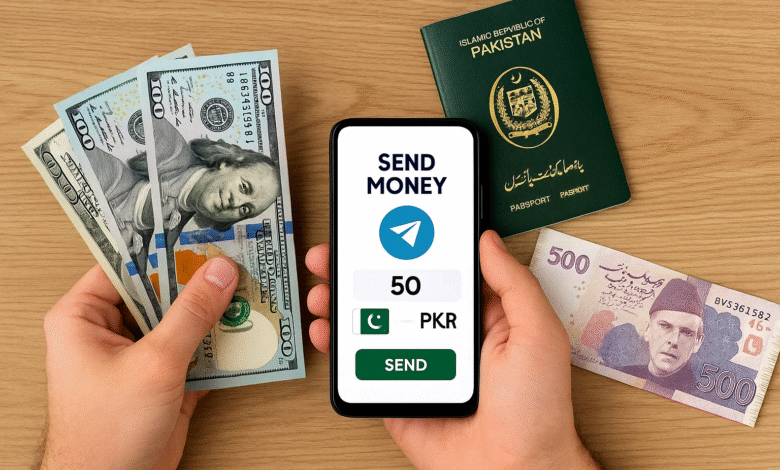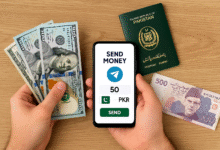
Sending money to Pakistan has become easier than ever before. Whether you want to support your family, pay bills, or handle business transactions, you have many options to send money to Pakistan from a foreign country. Millions of Pakistanis work abroad and regularly send money home.
In fact, Pakistan received over $31 billion in remittances in 2022, making it one of the top countries for receiving international money transfers.
This guide will walk you through everything you need to know about sending money to Pakistan, including the best methods, costs, requirements, and tips to save money on each transfer.
Why People Send Money to Pakistan
People send money to Pakistan for many different reasons. Understanding why you’re sending money can help you pick the right transfer method.
Common Reasons for Sending Money
- Family support – Many people send money to help their parents, siblings, or relatives with daily expenses
- Education fees – Students studying abroad often need money from family in Pakistan, and families send money back home for younger siblings’ education
- Medical expenses – Healthcare costs can be high, and families often help each other during medical emergencies
- Property purchases – Buying land or houses in Pakistan while living abroad
- Business investments – Starting or running businesses back home
- Emergency funds – Unexpected situations that require quick financial help
Best Ways to Send Money to Pakistan
There are several methods you can use to send money to Pakistan from a foreign country. Each method has its own benefits and drawbacks.
Online Money Transfer Services
Digital remittance platforms are the most popular way to send money today. These services are fast, convenient, and often cheaper than traditional methods.
Popular Online Services:
- Wise – Known for offering the real exchange rate with low, transparent fees. About 50% of their transfers arrive instantly, and 90% get there within 24 hours.
- Remitly – Offers promotional rates for new customers and has competitive pricing for regular transfers.
- Western Union – One of the oldest and most trusted names. They offer $0 transfer fees for bank transfers over $200 to Pakistan.
- MoneyGram – Has a large network in Pakistan with over 13,000 locations for cash pickup.
- Ria Money Transfer – Works with over 38,000 locations across Pakistan and offers both bank deposit and cash pickup options.
Benefits of Online Services:
- Transfer from your phone or computer
- Competitive exchange rates
- Lower fees compared to banks
- Fast delivery (minutes to 24 hours)
- Easy tracking of your transfer
Bank Wire Transfers
Traditional bank transfers are still a reliable option, especially for large amounts.
How Bank Transfers Work:
- Visit your bank branch or use online banking
- Provide recipient’s bank details (IBAN number)
- Pay the transfer fee
- Wait 1-5 business days for delivery
When to Use Banks:
- Sending very large amounts
- When security is your top priority
- If you already have a good relationship with your bank
Note: Banks usually have higher fees and less favorable exchange rates compared to online services. According to the World Bank, traditional banks can charge 5-7% in total costs for international money transfers.
Mobile Wallet Transfers
Pakistan has several popular mobile wallet services that make receiving money quick and easy.
Popular Mobile Wallets in Pakistan:
- JazzCash
- EasyPaisa
- SadaPay
- UPaisa
- NayaPay
- Finja
Benefits:
- Money goes directly to recipient’s phone
- Fast delivery (often instant)
- Recipient doesn’t need a bank account
- Easy for people in remote areas
Cash Pickup Locations
For people who don’t have bank accounts or mobile wallets, cash pickup is a great option.
How It Works:
- You send money through a service like Western Union or MoneyGram
- Recipient gets a tracking number
- They visit any agent location with their ID
- They receive cash immediately
Required Documents for Cash Pickup:
- Original CNIC (for Pakistani residents)
- Passport or NICOP (for overseas Pakistanis)
- Tracking number from sender
Also Read: Best Payment Gateways for E-Commerce in Pakistan
Step-by-Step Guide to Send Money to Pakistan
Here’s a simple process to send money to Pakistan from a foreign country using online services:
Step 1: Choose Your Transfer Service
Compare different money transfer services based on:
- Transfer fees
- Exchange rates (USD to PKR is currently around 280-283 PKR per dollar as of November 2025)
- Delivery speed
- Payout options available
- Customer reviews
Step 2: Create an Account
Most services require you to:
- Provide your name and email
- Create a password
- Verify your phone number
- Upload ID documents (passport, driver’s license)
This verification process helps prevent fraud and money laundering. It’s a one-time requirement that usually takes a few minutes.
Step 3: Enter Transfer Details
You’ll need to provide:
- Amount you want to send
- Recipient’s full name (exactly as it appears on their ID)
- Recipient’s phone number
- Delivery method (bank deposit, cash pickup, or mobile wallet)
- Recipient’s bank account or IBAN (if choosing bank deposit)
Step 4: Pay for Your Transfer
Payment options usually include:
- Debit card (often cheapest)
- Credit card (may have extra fees)
- Bank transfer from your account
- Apple Pay or Google Pay
Tip: Credit cards often charge higher fees, so use a debit card or bank transfer when possible.
Step 5: Track Your Transfer
After sending, you’ll receive:
- A confirmation email
- A tracking number
- Expected delivery time
Most services let you track your online money transfer through their app or website in real-time.
Costs of Sending Money to Pakistan
Understanding the true cost helps you save money on every transfer.
Transfer Fees
Transfer fees vary by:
- Service provider
- Amount you’re sending
- Payment method
- Delivery method
Examples:
- Wise charges around $28 for transfers
- Western Union offers $0 fees on transfers over $200
- Traditional banks may charge $30-50 per transfer
Exchange Rate Margins
The exchange rate is where many services make their profit. Here’s what you need to know:
- Interbank rate (also called mid-market rate) is the real exchange rate – currently around 280-283 PKR per USD
- Many services add a markup to this rate
- This markup can cost you more than the visible fee
Example: If you send $1,000:
- At the real rate of 281 PKR: Recipient gets 281,000 PKR
- At a marked-up rate of 277 PKR: Recipient gets 277,000 PKR
- You lose 4,000 PKR just from the poor exchange rate
Tip: Wise and some other services use the real exchange rate and only charge a transparent fee.
Hidden Costs to Watch For
Be careful of:
- Intermediary bank fees
- Receiving bank charges in Pakistan
- Poor exchange rates disguised as “no fee” transfers
- Higher costs for credit card payments
Requirements and Regulations
Documents You Need
To send money to Pakistan from a foreign country, you typically need:
For Sender:
- Valid government-issued ID (passport, driver’s license)
- Proof of address
- Bank account or payment card
- Tax identification number (for large amounts)
For Recipient:
- CNIC (Computerized National Identity Card) for Pakistani residents
- Passport or NICOP for overseas Pakistanis
- Bank account details (IBAN) if choosing bank deposit
- Mobile wallet number for mobile transfers
Transfer Limits
Different services have different limits:
- Daily limits: Usually $3,000-10,000 depending on the service
- Monthly limits: Can range from $10,000 to $100,000
- Annual limits: Some services allow unlimited transfers after verification
Note: According to State Bank of Pakistan regulations, there are no restrictions on inward remittances to Pakistan. However, sending countries may have their own limits.
Safety and Security
The State Bank of Pakistan regulates all foreign remittance coming into the country. Here’s what keeps your money safe:
Regulatory Protection:
- Services must be registered with FinCEN (in the US) or equivalent regulators
- Anti-Money Laundering (AML) checks
- Know Your Customer (KYC) requirements
- Transaction monitoring for suspicious activity
Security Features:
- Encrypted transactions
- Two-factor authentication
- Fraud detection systems
- Money-back guarantees from reputable providers
How to Choose the Best Service
Consider these factors when deciding how to send money to Pakistan:
Compare Total Costs
Don’t just look at fees. Calculate:
- Transfer fee + Exchange rate markup = Total cost
- Compare this across multiple services
- Choose the one that gives your recipient the most money
Check Delivery Speed
Different methods have different speeds:
- Instant: Some mobile wallet transfers
- Minutes: Cash pickup services
- Hours: Most online services to bank accounts
- 1-5 days: Traditional bank wires
Consider Convenience
Think about:
- Can the recipient easily access the money?
- Do they have a bank account or mobile wallet?
- Are there agent locations nearby for cash pickup?
- Is the service available 24/7?
Read Reviews
Check customer experiences on:
- Trustpilot
- Google Reviews
- App Store ratings
- Consumer forums
Look for comments about reliability, customer service, and problem resolution.
Tips to Save Money on Transfers
Send Larger Amounts Less Frequently
Fixed fees hurt more on small transfers. If possible:
- Combine multiple small transfers into one larger transfer
- This spreads the fee over more money
Example:
- Sending $100 with a $5 fee = 5% cost
- Sending $500 with a $5 fee = 1% cost
Compare Services Every Time
Exchange rates and fees change constantly. Don’t assume your usual service is still the best:
- Check 2-3 services before each transfer
- Look for promotional offers for new customers
- Some services offer better rates at certain times
Avoid Weekend Transfers
Currency markets are closed on weekends. Many services:
- Freeze exchange rates from Friday
- Add extra margins for weekend uncertainty
- May have slower processing times
Best time to transfer: Weekdays during business hours in both countries.
Use Bank Transfers Instead of Cards
Paying by bank transfer (ACH) is usually cheaper than:
- Credit cards (can add 2-3% in fees)
- Debit cards (may have smaller fees)
Sign Up for Rate Alerts
Some services let you:
- Set your target exchange rate
- Get notified when rates reach your goal
- Lock in good rates for future transfers
Common Problems and Solutions
Transfer Taking Too Long
Possible reasons:
- Bank holidays in Pakistan or your country
- Additional verification needed
- Incorrect recipient details
- First-time transfer (takes longer)
Solution: Contact customer service with your tracking number and ask for specific reason and estimated time.
Recipient Can’t Collect Money
Common issues:
- Name spelling doesn’t match ID exactly
- Wrong tracking number
- Missing required documents
- Agent location closed
Solution: Double-check all details match exactly. Contact the service for help if needed.
Money Sent to Wrong Account
Prevention:
- Verify IBAN carefully
- Send a small test transfer first
- Save recipient details for future use
- Double-check all information before confirming
If it happens: Contact customer service immediately. Many services can recall transfers if caught quickly.
Tax and Legal Considerations
Is Receiving Money Taxable in Pakistan?
Good news: Foreign remittances to Pakistan through official banking channels are tax-free. This means:
- Recipients don’t pay income tax on money received from abroad
- No withholding tax on remittances
- Part of Pakistan Remittance Initiative (PRI) to encourage legal channels
Reporting Requirements
In Pakistan: No reporting needed for legitimate remittances
In Your Country:
- US residents: Report foreign accounts over $10,000 (FBAR)
- Large transfers may need source of funds documentation
- Keep records for your tax returns
Avoiding Illegal Channels
Always use legal, regulated services. Avoid:
- Hawala or hundi systems (illegal in many countries)
- Unlicensed money changers
- Cash carried by travelers (risky and often illegal for large amounts)
Benefits of legal channels:
- Money is protected
- Faster delivery
- Better exchange rates
- You can track your transfer
- Helps Pakistan’s economy
Frequently Asked Questions
Q: Can I use PayPal to send money to Pakistan?
A: Unfortunately, no. PayPal doesn’t currently support sending or receiving money in Pakistan. You’ll need to use alternatives like Wise, Western Union, or Remitly.
Q: How long does it take to send money to Pakistan?
A: It depends on the method. Cash pickup can be instant, mobile wallets take minutes to hours, bank deposits usually arrive within 24 hours, and traditional bank wires take 1-5 business days.
Q: What’s the cheapest way to send money to Pakistan?
A: Online services like Wise and Remitly typically offer the lowest total costs because they use better exchange rates. However, compare multiple services each time since rates change daily.
Q: Do I need to pay tax on money sent to Pakistan?
A: No, incoming remittances through legal channels are tax-free in Pakistan. However, check your local country’s laws about reporting foreign transfers.
Q: Is it safe to send money online to Pakistan?
A: Yes, if you use licensed and regulated services. Look for companies registered with authorities like FinCEN (in the US) or equivalent regulators in your country. Stick with well-known names and check reviews before sending money.
Conclusion
Sending money to Pakistan from a foreign country is straightforward when you understand your options. Whether you choose online money transfer services like Wise and Remitly, traditional bank transfers, mobile wallets, or cash pickup through Western Union and MoneyGram, each method has its place depending on your needs.
The key is to compare transfer fees and exchange rates every time, choose services regulated by authorities like the State Bank of Pakistan for safety, and pick the delivery method that works best for your recipient. With Pakistan receiving billions in remittances each year, the infrastructure for international money transfers has never been better.
By following this guide and doing a quick comparison before each transfer, you can ensure your money reaches Pakistan safely, quickly, and at the lowest possible cost while staying fully compliant with all regulations.











